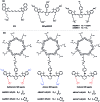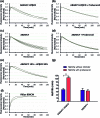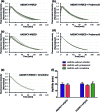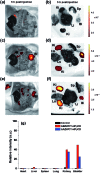Zwitterionic near infrared fluorescent agents for noninvasive real-time transcutaneous assessment of kidney function
- PMID: 28553500
- PMCID: PMC5431684
- DOI: 10.1039/c6sc05059j
Zwitterionic near infrared fluorescent agents for noninvasive real-time transcutaneous assessment of kidney function
Abstract
We developed novel zwitterionic near infrared (NIR) fluorescent agents (ABZWCY-HPβCD and AAZWCY-HPβCD), which exhibit favorable hydrophilicity, low plasma protein binding, high stability and non-toxicity. These attractive characteristics ensure that they are excreted rapidly, without any skin accumulation or metabolism in vivo. More importantly, zwitterionic HPβCD based agents can be efficiently filtrated by the glomerulus and completely excreted through the kidneys into urine without reabsorption or secretion in the kidney proximal tubule. Relying on these novel zwitterionic NIR agents and a transcutaneous device, we demonstrate a rapid, robust and biocompatible approach for assessing kidney function in rat models of both healthy rats and those with kidney disease, without the need for time-consuming blood/urine sample preparation. Our work provides a promising tool for in vivo real-time non-invasive kidney function assessment in preclinical applications.
Figures







Similar articles
-
Fluorescently Labeled Cyclodextrin Derivatives as Exogenous Markers for Real-Time Transcutaneous Measurement of Renal Function.Bioconjug Chem. 2016 Oct 19;27(10):2513-2526. doi: 10.1021/acs.bioconjchem.6b00452. Epub 2016 Sep 22. Bioconjug Chem. 2016. PMID: 27611623
-
Transcutaneous Measurement of Glomerular Filtration Rate in Rodents.Methods Mol Biol. 2020;2067:129-137. doi: 10.1007/978-1-4939-9841-8_9. Methods Mol Biol. 2020. PMID: 31701449
-
Release and pharmacokinetics of near-infrared labeled albumin from monodisperse poly(d,l-lactic-co-hydroxymethyl glycolic acid) microspheres after subcapsular renal injection.Acta Biomater. 2015 Aug;22:141-54. doi: 10.1016/j.actbio.2015.04.030. Epub 2015 Apr 27. Acta Biomater. 2015. PMID: 25929814
-
Near infrared imaging with nanoparticles.Wiley Interdiscip Rev Nanomed Nanobiotechnol. 2010 Sep-Oct;2(5):461-77. doi: 10.1002/wnan.77. Wiley Interdiscip Rev Nanomed Nanobiotechnol. 2010. PMID: 20135691 Review.
-
Preclinical pharmacokinetics: an approach towards safer and efficacious drugs.Curr Drug Metab. 2006 Feb;7(2):165-82. doi: 10.2174/138920006775541552. Curr Drug Metab. 2006. PMID: 16472106 Review.
Cited by
-
Constructing a Local Hydrophobic Cage in Dye-Doped Fluorescent Silica Nanoparticles to Enhance the Photophysical Properties.ACS Cent Sci. 2020 May 27;6(5):747-759. doi: 10.1021/acscentsci.0c00071. Epub 2020 Apr 22. ACS Cent Sci. 2020. PMID: 32490191 Free PMC article.
-
Potential Therapeutic Effects of Long-Term Stem Cell Administration: Impact on the Gene Profile and Kidney Function of PKD/Mhm (Cy/+) Rats.J Clin Med. 2022 May 5;11(9):2601. doi: 10.3390/jcm11092601. J Clin Med. 2022. PMID: 35566725 Free PMC article.
-
Light-Emitting Agents for Noninvasive Assessment of Kidney Function.ChemistryOpen. 2017 Jul 20;6(4):456-471. doi: 10.1002/open.201700065. eCollection 2017 Aug. ChemistryOpen. 2017. PMID: 28794936 Free PMC article. Review.
-
Molecular Visualization of Early-Stage Acute Kidney Injury with a DNA Framework Nanodevice.Adv Sci (Weinh). 2022 Jul;9(20):e2105947. doi: 10.1002/advs.202105947. Epub 2022 May 4. Adv Sci (Weinh). 2022. PMID: 35508712 Free PMC article.
-
The association of RBP4 with chronic kidney diseases in southern Chinese population.Front Endocrinol (Lausanne). 2024 Dec 4;15:1381060. doi: 10.3389/fendo.2024.1381060. eCollection 2024. Front Endocrinol (Lausanne). 2024. PMID: 39698033 Free PMC article.
References
-
- Jha V., Garcia-Garcia G., Iseki K., Li Z., Naicker S., Plattner B., Saran R., Wang A. Y., Yang C. W. Lancet. 2013;382:260–272. - PubMed
-
- Beierwaltes W. H., Harrison-Bernard L. M., Sullivan J. C., Mattson D. L. Comprehensive Physiology. 2013;3:165–200. - PubMed
-
- Stevens L. A., S Levey A. J. Am. Soc. Nephrol. 2009;20:2305–2313. - PubMed
-
- Qi Z., Whitt I., Mehta A., Jin J., Zhao M., Harris R. C., Fogo A. B., Breyer M. D. Am. J. Physiol. 2004;286:F590–F596. - PubMed
LinkOut - more resources
Full Text Sources
Other Literature Sources
Miscellaneous

